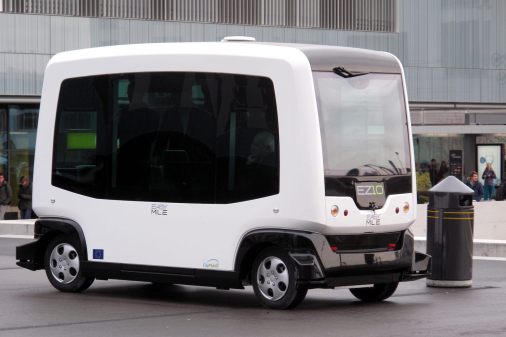Driverless shuttles coming to California’s Contra Costa County in 2017

New California legislation has opened the doors for a pilot project that, for the first time in the U.S., will allow fully autonomous vehicles — without steering wheels, accelerators, brake pedals or human drivers — on public roadways by 2017.
California Gov. Jerry Brown signed a bill Sept. 29 that will let Contra Costa County’s Transportation Authority (CCTA) test drive two autonomous shuttles. The pilot will begin testing at GoMentum Station, an abandoned naval yard in Concord, Calif., for about six months before sending vehicles for active duty at the Bishop Ranch Business Park in San Ramon, Calif., where about 30,000 workers will use the technology as part of their daily lives.
“You’ve heard all the reasons — efficiency, saving energy, utilizing space better, utilizing time, the human being gets much more power out of each day because of this new technology,” Brown told the Associated Press.
Brown has consistently put his name on bills that enable driverless tech. In 2015, he lauded the technology and signed a bill requiring the creation of performance and safety regulations for autonomous vehicle tests on state roadways. While crafted specifically for the pilot, regulators seek to use the legislation to fuel political and regulatory momentum for statewide trials.
Contra Costa County’s shuttle pilot is driven by a private-public partnership with the French tech and transit firm EasyMile. The international company functions through a joint collaboration with the Ligier Group, a transit car manufacturer, and the tech firm Robosoft, which will supply the navigational software. EasyMile has tested their shuttle in cities across Europe and Asia, but this will be its first time in North America.
In an interview with StateScoop, CCTA Executive Director Randy Iwasaki said testing will start as quickly as possible. The county just needs approval for a shuttle storage facility at GoMentum Station’s 5,000-acre facility.
“We’re going to start testing them, testing the sensors, going through the protocols to convince the National Highway Traffic Safety Administration (NHTSA), the California Department of Motor Vehicles and others that these vehicles are ready to operate.”
The pilot, Iwasaki said, came about after a public outreach campaign to update the county’s transit plan. Staff used social media, word of mouth, and telephone to get more than 15,000 participants dialed into town hall. Out of this, two thoughts emerged: that the county needed to do more with the transit resources it already has and that there were too many gaps between public transportation pickups and drop offs.
“We boiled it down to first-and-last-mile issues that are some of the major challenges the we face,” Iwasaki said.
This problem is especially noticeable with the Bay Area Rapid Transit (BART) system. The regional rail service connects the county’s suburbs to downtown San Francisco, and demand is often so high that cars are known to overcrowd. When problems like these are coupled with a tight transit budget, Iwasaki explained, alternative solutions like driverless shuttles begin to look reasonable.
“It’s either about figuring out a different way of providing access to [BART’s] facilities or building bigger parking structures,” Iwasaki said. “And the last time I checked, those parking structures cost about $50,000 a space.”
If the initial pilot is a success, the county’s goal is to deploy a fleet of 150 driverless shuttles. They would operate within a three-mile radius of various bus and rail transit stops. This kind of autonomous service would help low-income communities and disabled people, Iwasaki said.
“We’re trying to figure out ways of moving all of our people. Not just the people who can’t afford to own a car but the people who are disabled, we want to provide them with mobility.”
BART is partially financing the pilot, while additional dollars will be requested from federal DOT innovation grants and the state. Further, county residents will vote on a $2.8 billion measure in November that could fund the 150-shuttle expansion.






